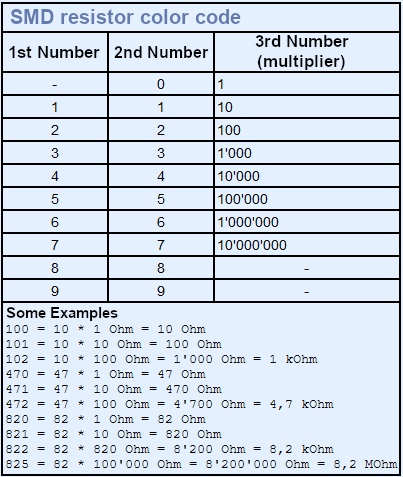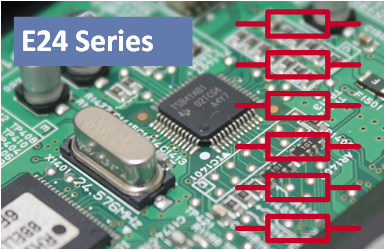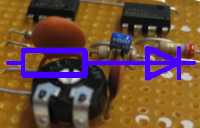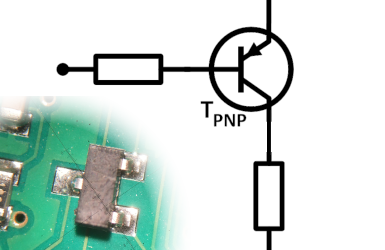Resistor Color Code
Here you will not only find the resistor color code table, but you will also find an explanation why resistors are having so
strangely illogical and uncool default values like "82 Ohm" or "5.6 Ohm" and why the ill-famed
E series actually make a lot of sense.
Color Code Tables with 4 rings, 5 rings and SMD Ressistors
You're just here to determine a resistance? Then click to enlarge one of the tables for the resistor color code.
330Ω, 560Ω, 820Ω,... Why do the resistors have such irregular values?
As if the resistor color code was not difficult enough, the resistors additionally all have very strange values. But although it doesn't
seem so at first glance: The E-series are strange, but they make a lot of sense.
Conveniently, all resistance series contain the integer powers of ten. These have each
the resistor colour code brown-black-black [potency]. On the logarithmic resistance scale they are like the rocks
in the surf of the odd-numbered flood:
The E rows are called e.g. E12, E48, E6 or E3. This means that they provide 12, 48, 6 or 3 resistors per decade.
So in the E3 series two more resistors are added between the already set 10 resistors. The resistor color code of
these parts is not shown in the next graphic:
Now these resistors get their values. Every resistor is dimensioned to be greater than the previous resistor
by a certain factor r. This factor r is constant through the whole E-range from resistor to resistor.
The factor r is calculated from the x-th root of 10, where x is the number of resistors in a decade.
So for the E3 row x = 3, for the E12 row x = 12, and so on.
This results in the resistance values for the resistors between the powers of ten.
For the E3 series, r is 2.154. This results in values between two powers of ten: 2.15 and 4.64. These are rounded to 2.2 and 4.7, thus defining the E3 series. Because the number of rings in the resistor color code is limited and resistors usually do not have to be dimensioned so exactly, the resistor values are rounded to two or three digits. Depending on the resistor color code, 4 or more rings are printed on the resistor:
For the E3 series, r is 2.154. This results in values between two powers of ten: 2.15 and 4.64. These are rounded to 2.2 and 4.7, thus defining the E3 series. Because the number of rings in the resistor color code is limited and resistors usually do not have to be dimensioned so exactly, the resistor values are rounded to two or three digits. Depending on the resistor color code, 4 or more rings are printed on the resistor:
X

Table 1: 4 Bands Resistor Color Code

Table 1: 4 Bands Resistor Color Code
X

Table 2: 6 Bands Resistor Color Code

Table 2: 6 Bands Resistor Color Code
X

Table 3: SMD

Table 3: SMD
X

Picture 1: resistor color code decade

Picture 1: resistor color code decade
X

Picture 2: Number of resistors in each decade

Picture 2: Number of resistors in each decade
X

Picture 3: The same factor between all the resistors

Picture 3: The same factor between all the resistors
X

Picture 4: Formula of factor r in a e-series

Picture 4: Formula of factor r in a e-series
X

Picture 5: E3-Series with resistor color code

Picture 5: E3-Series with resistor color code





